Don't wanna be here? Send us removal request.
Text

Eastern Ground Parrot (Pezoporus w. wallicus), BIG STEPPY!!!, family Psittaculidae, Jervis Bay, NSW, Australia
photograph by Subhranil Das
1K notes
·
View notes
Text
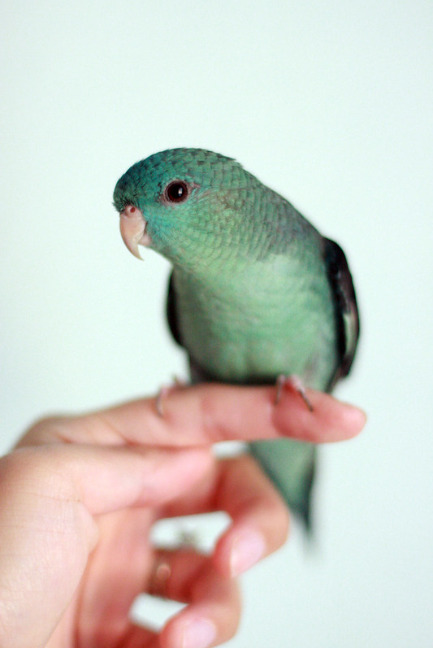
Kiwi2 - by Myra & Matt
#feathered friendz#exotic birds#feathered friends#avian enrichment#birds#avian friends#bird#bird photography#psittaciformian friendz#psittaciformes#psittaciformian friends#psittaciformian enrichment#parrots#parrot paradise party
2 notes
·
View notes
Text

Pale-headed Rosella (Platycercus adscitus), family Psittaculidae, order Psittaciformes, Australia
photograph by Jan Wegener
#parrot paradise party#psittaciformian enrichment#avian enrichment#parrot#feathered friends#exotic birds#psittaciformes#psittaciformian friends#bird watching#rosella
2K notes
·
View notes
Photo

Peach-faced Lovebird and Galah
#parrot paradise party#parrot#exotic birds#psittaciformian enrichment#avian enrichment#psittaciformes#psittaciformian friends#feathered friends#cockatoo#parrots#love birds#galah cockatoo
57K notes
·
View notes
Photo

42° 56′ 43.43″ S, 171° 33′ 56.44″ E
#psittaciformian enrichment#parrot paradise party#kea#parrot#feathered friends#avian enrichment#psittaciformes#psittaciformian friends#new zealand#exotic birds
3K notes
·
View notes
Photo

Purple-crowned lorikeet (Glossopsitta porphyrocephala).
#purple-crowned lorikeet#glossopsitta#glossopsitta porphyrocephala#psittaciformes#psittaculidae#parrot paradise party#psittaciformian enrichment#avian friends#avian enrichment#feathered friends#feathered friendz
177 notes
·
View notes
Text
Costa Rica Is Saving Forest Ecosystems by Listening to Them - by Geraldine Castro | WIRED - SCIENCE | 25th/02/2025
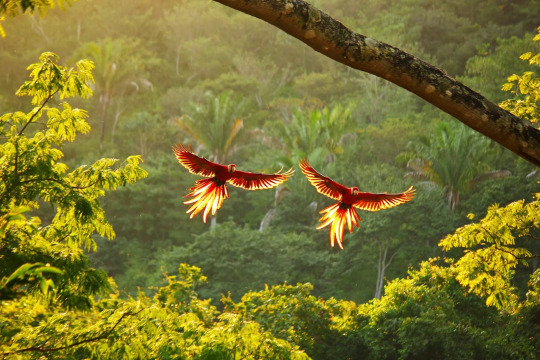
Monitoring Noises in Eco-Systems Reveals Their Health, Allowing Researchers to Monitor Bio-Diversity Changes, Detect Threats & Asess the Effectiveness of Conservation Strategies.
Photograph: Charlie Fayers/Getty Images
Monica Retamosa was in the middle of changing the batteries of a tape recorder when she heard a bellbird for the first time. Standing on a forest floor, she looked up into the trees, scanning for the source of its metallic and powerful sound, searching for the bird for half an hour to no avail. The bellbird sings from the treetops where it is visible to its peers but invisible to those below. Still, Retamosa smiled: She cares for ecosystems in Costa Rica’s AmistOsa Biological Corridor by listening to them.
In nature, living things use sound for almost everything. They make calls to attract mates, communicate identities, warn of dangers, guide the way, and help in hunting or defense. For decades, researchers have tracked species with recorders in hand, and still do, though increasingly are using remote recording devices too. The study of the sounds organisms make is known as bioacoustics. Retamosa has been doing this work for 10 years. Using bio-acoustic recordings, studies have shown that some birds shout loudly to make themselves heard in cities and that sea turtle hatchlings communicate from the nest to coordinate their hatching. And when bioacoustics is combined with other sounds—those made by humans, as well as the natural sounds of the landscape, such as the crashing of waves in the sea—it is possible to interpret deeper ecological meaning. It becomes possible to monitor changes in biodiversity, detect threats, and measure the effectiveness of conservation strategies. This wider analysis of sound is known as eco-acoustics—and it is exactly the work underway here in Costa Rica.

A three-wattled bellbird (Procnias tricarunculatus) in Costa Rica. Photograph: Juan Carlos Vindas/Getty Images
The development of automated recordings revolutionized bioacoustics and ecoacoustics. Now, research groups can hang sensors that record snippets of the day for months at a time without interfering with wildlife. Retamosa likes this strategy because it’s non-invasive to animals, makes it easier to have ears in large areas and hard-to-reach places, and occasionally helps discover mysterious species.
Although she prefers to monitor ecosystems from a distance, Retamosa still has to go deep into the forest to set up recorders. Visits to the field are fascinating, but never a Sunday stroll. She has hiked miles through mud and branches, along with her colleagues Jimmy Barrantes and Randall Jiménez. They have gone up and down endless slopes. Once, she fell and fractured her ribs. But the work doesn’t end with the installation: they have to go back to change batteries and memory cards. In other countries, they use solar panels and the internet to receive real-time data; in the dark, humid rainforests of Costa Rica, it’s still done by hand.
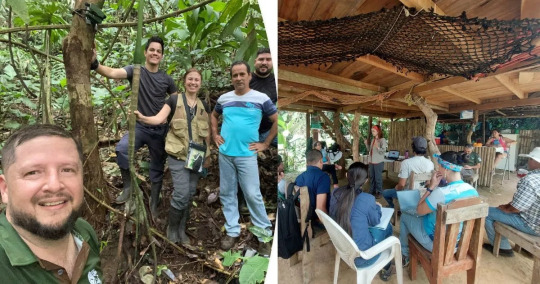
Acoustic-monitoring fieldwork in Costa Rica. Photograph: Courtesy of Jimmy Barrantes & Randall Jiménez.
That’s what Retamosa was doing when she heard the bellbird. That recording forms part of a project to track the movement and distribution of these birds, which migrate between different altitudes in the region. Their presence could be a functional indicator of the state of the AmistOsa Biological Corridor, which connects La Amistad International Park, on the border with Panama, with other reserves in southern Costa Rica.
The biological corridor was shaped by the passage of wildlife that emerged following the 1990 Forestry Law, which protected wilderness areas and encouraged reforestation on farms through payments for environmental services. In 2010, it was officially mapped. Today it runs through indigenous territories and crosses the country’s largest wetland. Across the Costa Rica there are now 53 corridors, covering 38 percent of its territory.
The project data will help the committee in charge of Costa Rica’s biodiversity and natural resources make decisions. “The idea is to make a monitoring protocol, linking the government, the communities, and us as academia, providing support for analysis and interpretation,” Retamosa says.
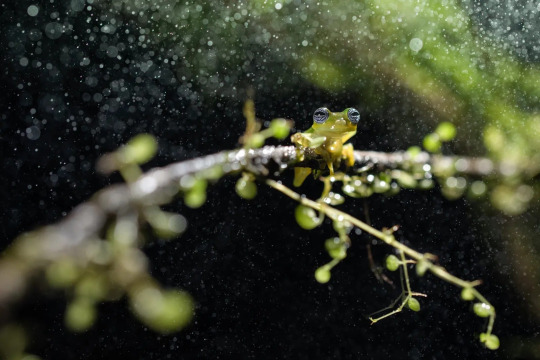
A Limón giant glass frog in the rain in Braulio Carillo National Park in Costa Rica. Photograph: Christopher Jimenez Nature Photo/Getty Images
Recorders hung in the wild capture many terabytes of data, so listening to every recording is not feasible. With an eye toward making it a cost-efficient strategy, researchers have developed acoustic indices: mathematical formulas to interpret ecosystem traits from the recorded sounds. “They can reflect the acoustic energy of a place, activity, or frequency diversity,” Retamosa explains. When she started in this field, there were only eight acoustic indices. Now there are more than 80.
The discipline is advancing so rapidly that the scope of these indices is currently being debated. In some of her early research, Retamosa found that certain acoustic measurements show variations between tropical and temperate regions. One of the best known, acoustic complexity—the degree of variation and intricate structure of bioacoustic sound—has been used as a descriptor of bird diversity in temperate environments. However, in tropical areas, different investigations have shown that it does not reflect species diversity, but rather the level of acoustic activity; that is, instead of indicating the presence of multiple species, it seems to show the intense vocalization of one or a few birds.
Careful analysis of these indices can be used to reveal the health of the forest. In a report with Jimmy Barrantes, Retamosa outlines that measuring acoustic entropy—the variation of sound intensity across time and audio frequencies—and acoustic diversity helped them to classify the state of disturbance of some sites, while those of acoustic activity and energy did not. “You can use the indices for a first exploration of the site, to do studies over time, looking for specific changes associated with human disturbances and work with key species,” she explains.
Listening for the Impacts of Tourism
Every region has its own environmental concerns. In Costa Rica, tourism has grown dramatically: between 1984 and 1989, international arrivals increased 37 percent, from 273,900 to 375,900 visitors. But since 1990, the pace has skyrocketed: last year the country received 2.6 million tourists. This boom poses sustainability challenges. To address them, the International Institute for Conservation and Wildlife Management team analyzes sounds inside and outside protected areas. One of its tools is an index that measures the ratio between biological sounds and human-made noises.

The acoustic quality of the landscape must be monitored to conserve the country’s ecotourism. Photograph: Jordan Siemens/Getty Images
In recent years, automated acoustic detection, using artificial intelligence and machine learning, has revolutionized species identification. Previously, advanced programming skills were required to use AI, but with the advent of accessible interface models, it’s becoming more popular. Exoacoustics is increasingly focused on developing more accurate models for classifying sounds.
And it’s becoming possible to pick out individual species in the soundscape using these tools. In a study of farms conducted as part of the Bosque Vivo project, run by Costa Rica’s National Forest Financing Fund, the research team found that Hylopezus perspicillatus, a bird species sensitive to landscape disturbance, was only present in the control sites of Corcovado National Park and in the forests of the best-conserved farms.
In Guanacaste, Retamosa is also working on a long-term monitoring protocol to evaluate how ecosystems and biodiversity are responding to climate variability. In other countries, similar projects are recording sound baselines in sites with minimal human intervention that, in the future, could be compared with up-to-date recordings to detect changes. Although storing all these records is costly, Retamosa believes that they’ll form an invaluable historical archive, which one day can be returned to when technology allows further analysis.
This story originally appeared on WIRED en Español and has been translated from Spanish.

2 notes
·
View notes
Text
Untouched by Time, This Pristine World Soars High Above the Amazon | Article by Mark Synott, Photography & Video by Renan Ozturk | The National Geographic Magazine | 22nd/03/2022
A flat-topped peak gives researchers a chance to identify new species and unlock secrets of evolution. The biggest challenge: getting there.
0 notes
Text
youtube
Why are Wild Parrots Disappearing in Miami? | Short Film Showcase - National Geographic
In Miami, conservationist Daria Feinstein is on a mission to save the beautiful Blue-and-Yellow Macaw—before it's too late.
Since the species is not native to Florida, they are not protected by state law and poachers can legally capture the birds and their chicks for the lucrative pet trade. Watching the local population dwindle, Feinstein fights to raise awareness and protect her beloved birds for future generations in this short by Day's Edge Productions. (http://www.daysedge.com/).
#Youtube#parrot paradise party#macaw#avian enrichment#feathered friendz#feathered friends#exotic birds#birds#parrots#parrot#bird in flight#bird watching#exotic bird#exotic pets#exotic animals#avian friends#psittaciformian enrichment#psittaciformian friendz#psittaciformes#macaws#florida#miami
2 notes
·
View notes
Text

Mulga Parrot (Psephotellus varius), male, family Psittaculidae, order Psittaciformes, Western Australia
photograph by Darren Stephens
2K notes
·
View notes
Photo
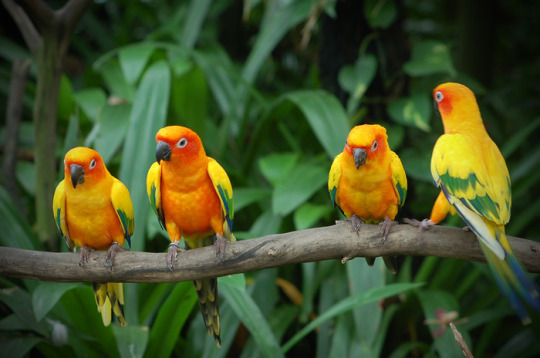
#psittaciformian enrichment#parrot paradise party#feathered friends#parrot#psittaciformian friends#psittaciformes#avian enrichment#bird watching#conure
21K notes
·
View notes
Note
How many kinds of “blue” macaw are there? I knew of hyacinth and spix’s, but not the indigo/lear’s.
Hyacinth, Spix's and Indigo/Lear's are the only species I know of... (as far as mainly blue macaws).

Hyacinth Macaw (Anodorhynchus hyacinthinus), nesting pair, family Psittacidae, order Psittaciformes, found in central and eastern South America
photograph by Jeff Muñoz Rainforest Photo Tours

Lear’s Macaw aka Indigo Macaw (Anodorhynchus leari), family Psittacidae, order Psittaciformes, found only in northeast Bahia, Brazil.
ENDANGERED.
photograph by Col Roberts Photography


Spix's Macaw (Cyanopsitta spixii), family Psittacidae, order Psittaciformes, historically found in the Caatinga habitat of eastern Brazil
ENDANGERED.
This species went extinct in the wild, and is being reintroduced into a small area of its historic habitat.
photographs by Danny Ye
#parrot#psittaciformes#psittacidae#ornithology#macaw#bird#psittaciformian enrichment#avian enrichment#hyacinth macaw#spix macaw#animals#nature#south america#parrot paradise party#parrot photography#feathered friends#feathered friendz#bird watching
460 notes
·
View notes
Photo

Blue & Gold Macaw
*This is my own photography*
9K notes
·
View notes
Text

(by David Clode)
#parrot#psittaciformian friendz#psittaciformian friends#psittaciformian enrichment#parrot photography#parrot paradise party#feathered friends#feathered friendz
271 notes
·
View notes
Text
To Help a Rare Brazilian Parrot, Start With a Crossbow & Rappelling Beekeepers | By Greg Uyeno | Atlas Obscura | 15th/03/2021
0 notes
Text
youtube
How Tropical Birds Create Their Vibrant Colors - The Science Behind It! | Terra Mater
From Parrots to Peacocks, we’re all Familiar with Brightly Colored Birds. Our Feathered Friends use Vivid Pigments to Attract a Mate – But Where do They Get Their Vibrant Colours From? And is it true that Tropical Birds are Brighter Than Their Cousins From the North?
Humboldt & Darwin Certainly Thought so – Yet it Took Scientists until 2022 to Prove Their Theory Right. Now, thanks to Mathematical Colour Analysis & Over 24,000 Images, We Know that Tropical Birds are Roughly 30% More Colourful Than Their Temperate Counterparts! But Where do Their Vivid Pigments Come From? Join us on a Fascinating Journey into Bird Feathers, Where we Discover the Foods, Pigments & Microstructures Making Flamingos Pink & Turacos Green.
4 notes
·
View notes
